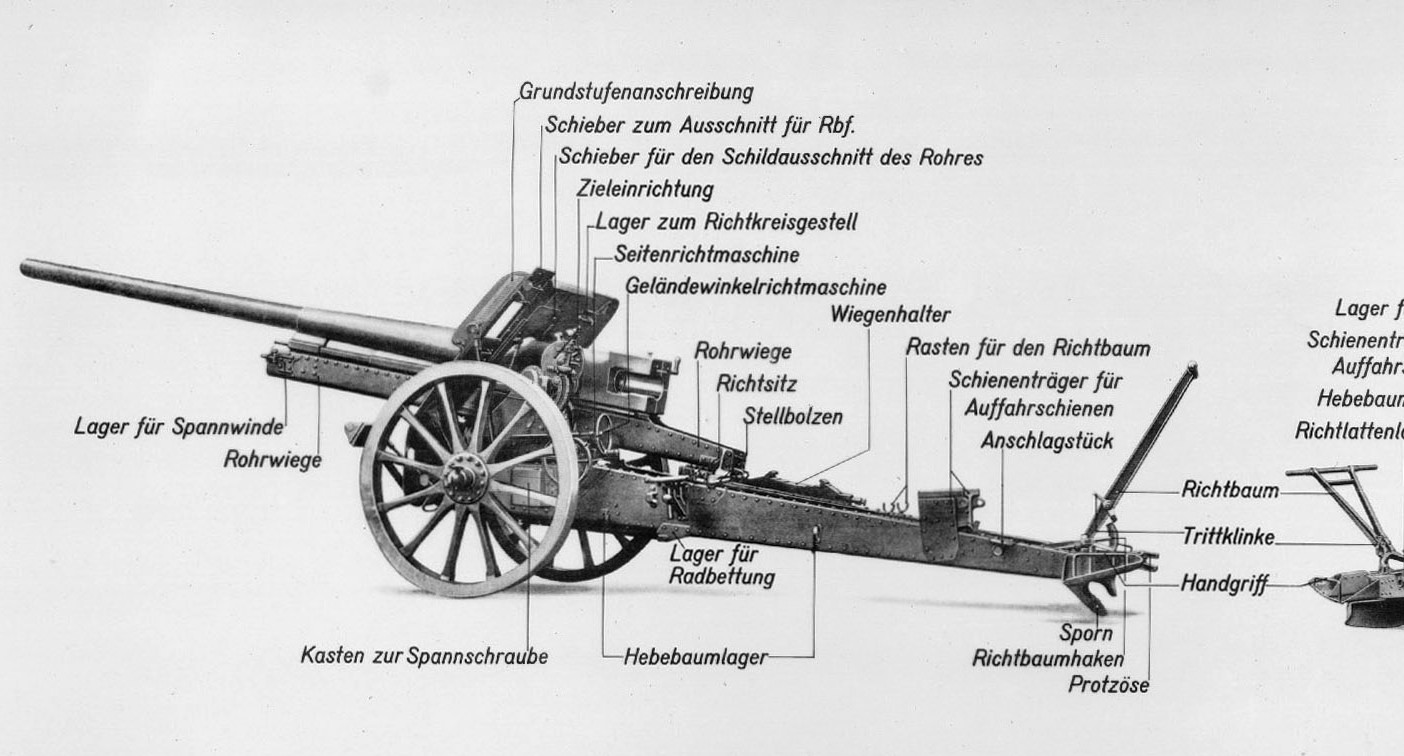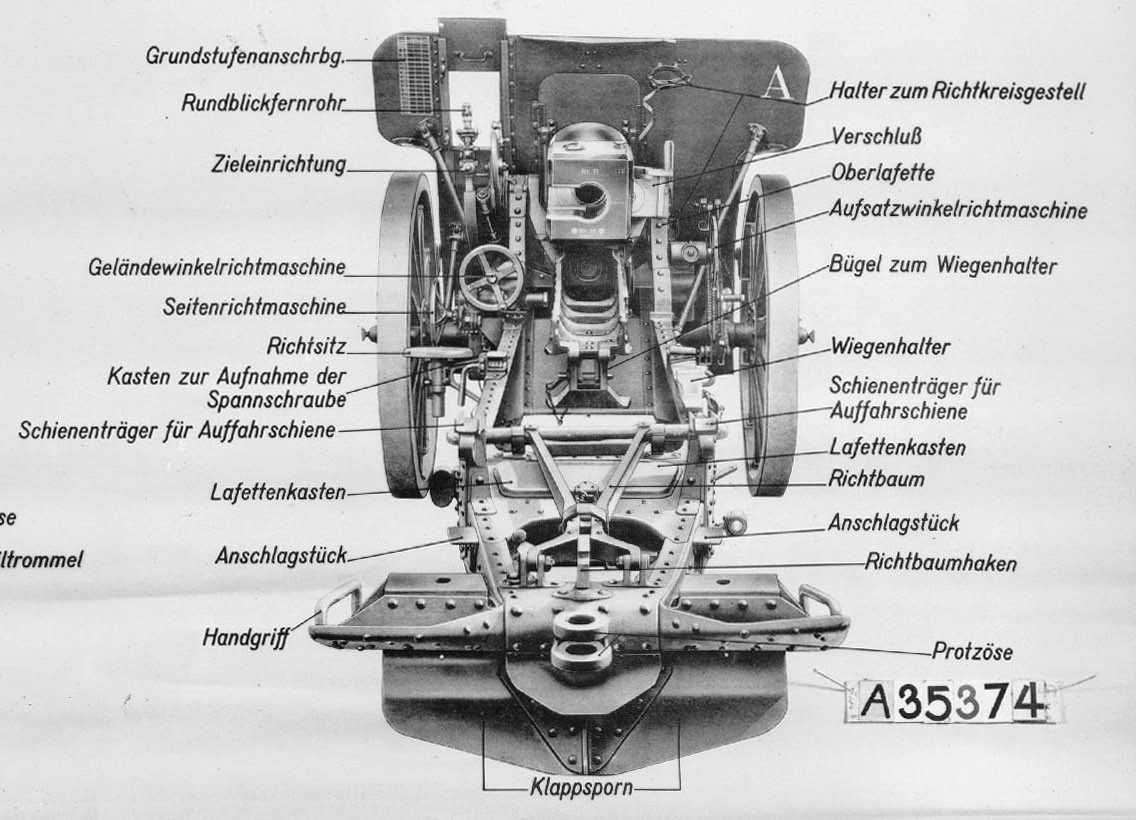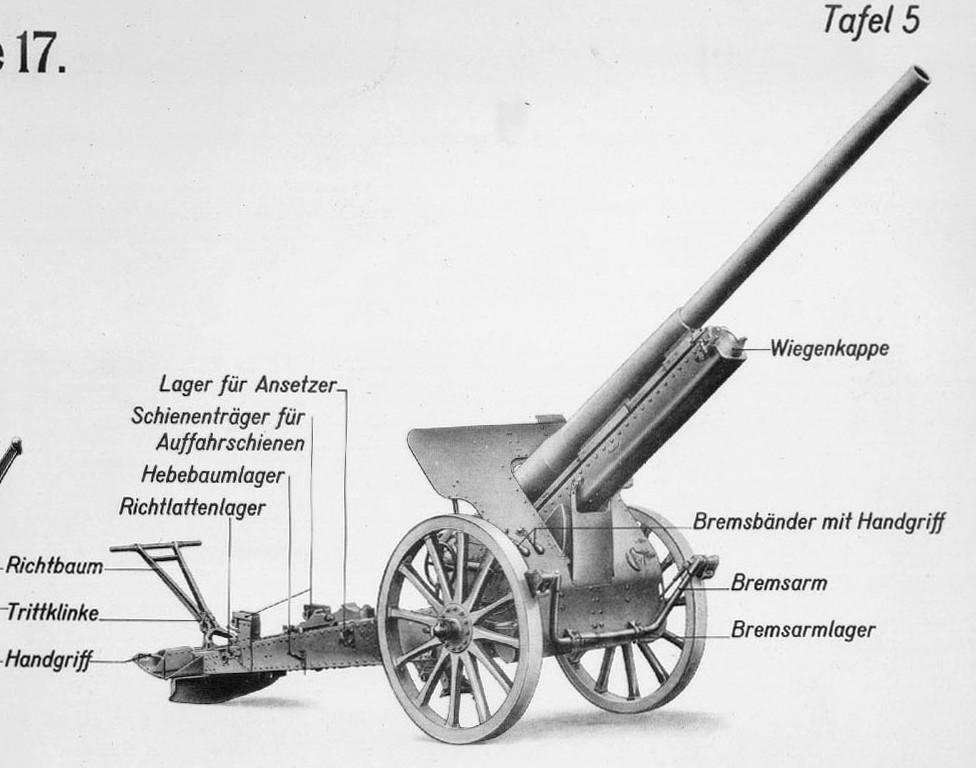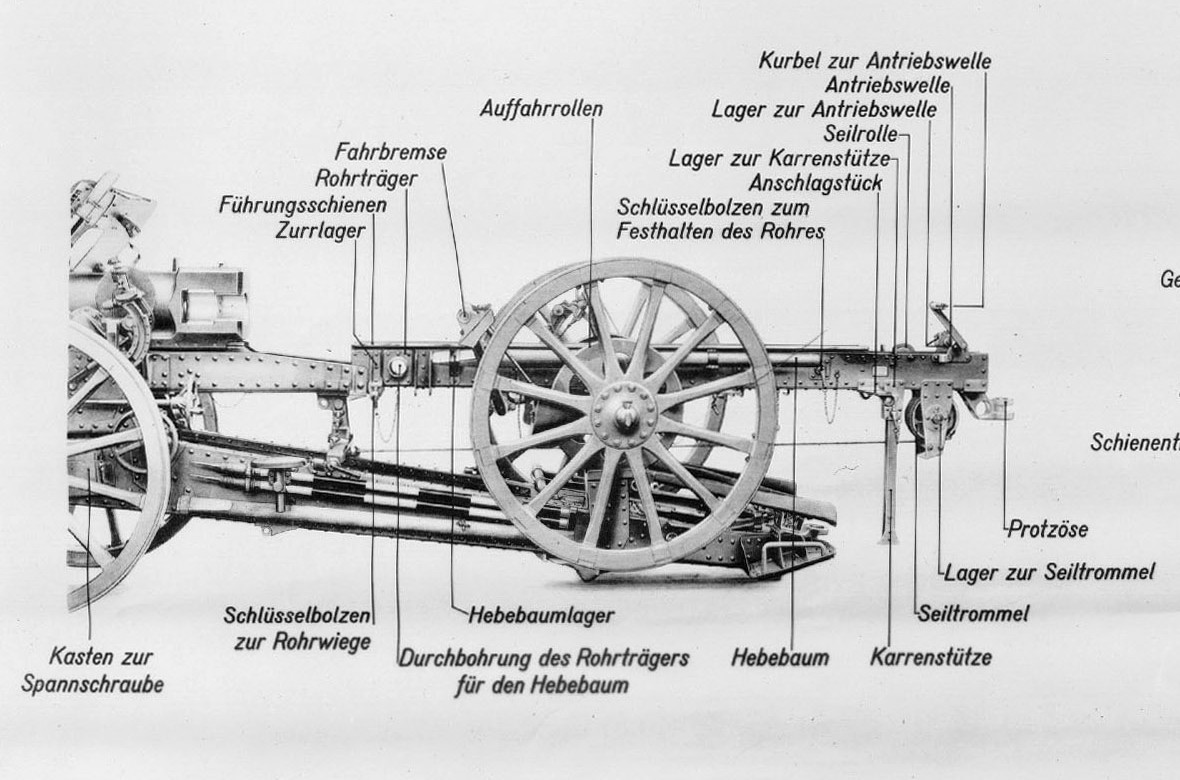105 mm - Light Fieldgun 10cm K 14
In 1911, the APK (German Artillery Test Commission)requires new expectations for an evolution of the 10 cm K 04. Rheinmetall and Krupp both present a gun, and once again it's Krupp who wins with its design in 1914.
This '10 cm K 14' differs a lot from the 1904 previous gun. An elongated tube (35 calibres instead of 30), a modified recoil system, a new breech, a firing platform to allow a rapid direction aiming upon 360 degrees, and two separate elevation aiming systems, one for the flat trajectories, and the other one for the indirect fire. Finally, a shield is now protecting the crew, very welcome against the counter-battery shelling.
As a consequence of the longer tube, the K04 range performance was kept but with a heavier shell. This 10cm K 14 proved to be an excellent weapon on the battlefields, polyvalent but more and more specialised in the counter-battery fire. On the other hand, the expectations of getting this weapon abilities in anti-aircraft fire were never met.
724 such guns '10 cm K 14' ('K' = Kanone = Gun) were manufactured by Krupp during the war. 368 were still in service in November 1918. This gun was still in use in the 3rd Reich armies during WW2.
Main characteristics :
Weight in firing position : 2820 kg
Calibre : 105.2 mm
Longueur du tube : 35 calibres
Number of grooves : 32
Projectile weight : 18.75 kg
Initial velocity : 583 / 585 m/s
Maximum range : 11400 / 13100 m
Elevation range : max +45 degrees
Direction range : 6 degrees total range
DEVELOPMENT OF GERMAN 10CM HEAVY FIELD GUNS By Ralph Lovett
In 1893 the German Army’s Foot Artillery put into service the 15cm. Heavy Field Howitzer 1893 (15cm. s.F.H. 1893). This piece pioneered the role of heavy artillery in support of maneuver. With it, theories of indirect fire were applied in a production maneuver weapon for the first time. As is the case with all artillery developments, there was a long and difficult period before maneuver commanders were “sold” on the idea of heavy artillery in support of their fast moving maneuver units. Through field test, frequent evaluation in pre-war maneuvers, and research such as Lt. General Rohne’s New Study on Shrapnel Fire the howitzer types proved themselves. They were shown to be reasonably mobile and able to mass greater effects on dug in infantry and counter-battery targets than competing flat trajectory gun designs. This line of development had the full support of the German Kaiser, which rather forced its acceptance among maneuver commanders. The result was that German Foot Artillery was almost twenty years in development ahead of Allied countries in 1914.
Despite the emphasis on the howitzer in German artillery doctrine, a place was still seen for the flat trajectory gun in both the Field and Foot Artillery. Flat trajectory fortress and field guns were still developed for German Army service. The majority of German Foot Artillery Units from the turn of the century through the war were howitzer units, but there seems to have been a persistent doubt about indirect fire associated with the howitzer. After all, it was not combat proven with German maneuver units, engaged with a major power. Evidence of this doubt can be seen on pre-war howitzers and guns such as the s.F.H. 1902 and Kanone 1904 in the form of “iron” sights fixed on their tubes for "emergency" direct fire. Further evidence of this “doubt” can be seen simply by the fact that effort was put into a flat trajectory gun at all.
The pre-war 10cm design requirements called for a siege gun capable of firing behind a parapet without the use of a firing platform. In this context “siege gun” implies a weapon in which the gunner can sight directly on his target, usually overlooking it from a greater elevation. Additionally, requirements for the 10cm. Kanone 1914 called for an ability to directly engage aircraft. Early in the war, demands for these flat trajectory guns increased to such a degree that to supplement this need, many captured foreign tubes were put into service along with German Naval and fortress flat trajectory pieces.
The design of early non-recoil, heavy field guns such as the s. 9cm K., s. 12cm K., 15cm RK, lg. 15cm K. and the 10cm K. differs from that of the 15cm. Heavy Field Howitzer, in that the gun’s barrels were set very high on their carriages. In this way the barrel could protrude over breastworks while the crew stood behind its cover. It was expected that the gunner would generally be able to see his target, without the need for forward observers, as were utilized with the howitzer. The greater range attributed to the gun was not used to its fullest in this way, but its greater velocity, accuracy and rate of fire was expected to have good results on individual targets. Because of the high barrel mount these guns were very unstable without firing foundations. Consequently, the amount of materials, and horse-teams necessary to emplace them was greater than that of the s.F.H.”93.
From their initial design the 10cm Kanone 1904, 1914 and 1917 had indirect fire sights (with a direct fire scope) of the same types used on the 15cm. s.F.H. 1902, 1913 and lg.1913. Only their sight-mounts and range drums varied. Despite this, I am of the opinion that the true value of this combination of indirect fire sight fitted onto a flat trajectory gun was not appreciated until its capabilities were seen first hand in the early months of the war. It appears that late war sources use the term “far ranging” to describe these pieces, with less emphasis placed on their rapidity of fire and anti-aircraft capability, which was frequently noted earlier. The latter two, being deemed most important before the war. These pieces out ranged most other field pieces because of their lower angle fire and higher velocity. They, of course still had the limitations of a relatively small projectile and poor dispersion characteristics of a gun verses a howitzer. Within the Great War, technology developed which had great application for these weapons. High explosive comes to mind first, but with equal importance were chemical munitions delivered by flat trajectory weapons, which had great effect relative to their projectile size. Also dispersion was less a problem because of the great area of effect with poison gas. New target acquisition means were developed with long range capabilities such as sound ranging, flash ranging and aerial observation. In this new context the 10cm and other flat trajectory guns often served a counter battery role.
Early in 1893 the Artillery Armament Test Agency (A.P.K., Kgl. Preussische Artillerie-Pruefungskommission) issued a report concluding that the schwere 12cm. Kanone 1880 (s. 12cm K.) no longer met the demands of the field army. Its rate of fire was insufficient, long-range accuracy and effects on target were inadequate. To solve the problem quick loading breech and fixed ammunition (with shell case) was proposed. Additionally, the carriage was to be improved and the muzzle velocity increased, in an effort to improve accuracy. It was also considered that the weight of ammunition should not increase. To standardize ammunition the Naval 10,5cm caliber was considered. Designs for fortress artillery were also expected utilizing this same ammunition.
Following this report, the Ministry of War laid out plans for 10cm guns to be built for the Foot Artillery of the field, along with fortress guns of 10cm caliber with overhead shield and turret-mounts. The resulting field weapon was designated 10cm Kanone 1899. Its high carriage was only reduced 20mm from that of the s.12cm.K. A recoil buffer was connected from the platform to the trail and wedges behind the wheels were used for counter-recoil. The weapon was not stable enough to fire without a platform, despite experiments with a rake-like devise to widen the trail. The gun tube design was similar to its fortress counterparts. It had a vertical sliding wedge breech with extractors to eject the shell case after firing. K.”99 rifling was of increasing pitch . Smokeless powder propellant R.P. 97 was used with this weapon. Its tube weight with breech was 1280 kg. and carriage weight of 1360 kg. giving a total weight of 2640 kg. This weight is 440 kg. over that of the s.F.H. “93 and was most likely considered excessive to testing boards as well as maneuver commanders. 4 On the positive side, the K.”99’s range was impressive, 10200 m with a higher rate of fire. This is compared to the 12cm. Kanone 1880’s maximum range of 7900 and the 6050m. range for the s.F.H.”93. Krupp continued to experiment with their K.”99 adding an elastic spade to supplement the hydraulic recoil brake fitted under the gun. Unfortunately the system recoiled so violently that the piece had to be re-laid after each firing.
During the same time period that Krupp’s 15cm.Experimental Howitzer ( V.H. “99) was undergoing trials, Ehrhardt was ask to design a 10cm gun with traversing and recoil mechanisms, in which a platform was not necessary. The results were the 10cm Ehrhardt Model 1902 and Model 1903. The 10cm. Ehrhardt “02 was tested 30 September 1902 at the Kummersdorf proving grounds and showed serious deficiencies. The gun was still not ready for the Duesseldorf exhibition later that year. The design evolved into the 10cm “03 with reduced firing height and a range of 10000 meters. However, by this time Krupp had developed a competing 10cm. design which proved very successful at Kummersdorf. 5 Krupp built six of these 10cm weapons for mobility test in 1904 and was so successful that it was put into production the following year under the designation 10cm Kanone 1904. Not only was the 10cm K. “04 a replacement for the K. “99 but also for the lang 15cm. Kanone 1892. 6 Previously, the lg.15cm Kanone was considered a preferable gun because of the greater amount of shrapnel within its projectiles. However, this changed with the higher rate of fire, due to the recoil mechanism of the 10cm. K. 1904. The 10cm K.”04 is a gun in the same level of development as the 15cm. s.F.H. 1902 howitzer . The German designation for flat trajectory guns being (K) kanone as opposed to howitzers with arching trajectories designated (H) haubitze. Experience gained with the s.F.H. “02 was applied to the K. “04. Reed mats were stored away on the limber as replacements for the, once necessary, firing foundations. These mats prevented the weapon from sinking into the ground while firing but did not take up the space or have the burden of weight of the heavy wooden foundations. Field exercises with maneuver had begun to show the capabilities of the heavy artillery for the field and accuracy had begun to improve. 7 Although the 10cm was effective as a direct fire weapon the K.”04 like the s.F.H. “02 was fitted with a dial like, optical indirect fire sight. This sight was graduated in sixteenths of a degree or from 0 to 5760. With this sight an aiming circle (also 0-5760) was used to direct a firing battery on a distant target. Forward observers with field phones, ahead with the infantry called for fire and adjusted fire onto enemy positions. The Control Station (FDC) received these spottings and corrected for meteorological conditions as well as calculating data such as quadrant and defection for the battery. At the firing position, cannoneers made settings on the sights according to data received from the Control Station for the distant target. 8 In other words the technique developed along with the s.F.H. and is “basically” used to this day. Note: The 0-5800 half-circle sight (Richtkreis) is only used with the K. “04 as an expedient.
The K. “04 has a simple elevation mechanism with an operating handle on the left side of the carriage. The traversing mechanism is similar to the s.F.H. “02, but simpler, with a small handle mounted directly to the worm gear. This traversing mechanism allowed for 20 degrees of movement left and right. Many of the problems with variable recoil encountered with the s.F.H. “02 were not present in the development of the K. “04. I believe this is so because the K."04 is a gun, and unlike the howitzer does not require high elevation. Its maximum elevation is only 30 degrees as opposed to the 42 degrees elevation for the s.F.H. "02. A simple hydro-spring recoil with constant recoil length was employed, in contrast to the variable recoil for howitzers.
In 1909 and 1910 at Frisches Haff along the Baltic coast the 10cm Kanone 1909 was tested against aerial targets. It was judged superior to weapons of smaller calibers in this role. Due to the rapid progress achieved with aircraft technology in this era it was believed necessary to further improve the K.”04. Quicker laying, development of a faster loading mechanism and a 65 degree elevation mechanism were recommended, but were not seen as possible while retaining the basic K.”04 design. The Artillery Armament Test Agency felt something entirely new was called for. The General Staff, the Inspector General of Foot Artillery and the Ministry of War agreed.
By 1911 the Artillery Armament Test Agency specified the requirements for the new 10cm design. The Ministry of War allowed for Krupp and Ehrhardt (Rheinmetall) to produce one experimental gun each. The Krupp experimental gun no. 1 had a tube 35 calibers in length, a horizontal sliding wedge breech of the Ehrhardt system, variable recoil, rear set trunnions, spring equilibrator, traversing system with a range of 6 degrees, range and sight elevation systems, and elevation from –5 to +45 degrees. The gun delivered in the fall of 1912 proved to be too heavy so that the tube was cut to a length of 30 calibers and the shield thickness was reduced. In 1913 tests conducted with these two weapons were productive and led to further modifications. Two additional experimental pieces with similar characteristics were ordered. These two weapons were submitted to comparative test against aerial targets, some of which were conducted at the Swinemuede test site. A critique of these two 10cm experimental types were given in a letter to the General Staff written by the Ministry of War on 8 March 1913:
“… so far the tests have shown that both guns more or less meet the requirements, generally speaking. However, the 10cm experimental gun designed by Krupp needs to be improved in the areas of accuracy of fire and stability whereas the Rheinmetall design needs an improved and simplified laying mechanism and a reduction in weight to be brought about by cutting down the barrel.
Based on these suggestions new experimental guns were produced by Krupp and Rheinmetall (Ehrhardt) by 1914. Mobility tests conducted in the Sudeten Mountains went well for both pieces. With the outbreak of war in August 1914 the Krupp piece went into service as the 10cm Kanone 1914, with 128 initially ordered. In the course of the war, 724 of this design were delivered by Krupp. In May 1915, the first 10cm battery was reequiped with 10cm K.”14s
The K.”14 has three unusual features. First, a semi-automatic horizontal sliding wedge breech, much like those seen on anti-tank guns of W.W.II. Second, are two elevation systems. On the right, range elevation is adjusted and on the left is the adjustment for angle of sight . Third, is a firing platform, not to aid recoil but set under the gun enabling speedy 360 degree traverse. These features are due to the K.”14s calling as an anti-aircraft gun. The trunnions were set rearwards, resulting in more clearance for recoil. This feature is much the same as seen in the s.F.H. “13. A very large single spring equilibrator is set between the carriage and the cradle. This equilibrator puts pressure upward on the muzzle end of the cradle. In effect, this makes the elevation gearing more balanced, and easier to elevate and depress. The piece has a recoil length of 1550mm, which is automatically variable up to 950mm. It seems that increased elevation was given in order to engage aircraft. This 45 degree elevation, over the 30 degrees of the K.”04, evidently necessitated variable recoil. The recoil type is hydro-spring. A range drum, which calculates the range elevation portion of quadrant, is mounted to the left. The drum has two rows of graduated markings for degrees in elevation (Gr) and range (m) with linkage for this range drum set above the barrel. Range elevation is the calculation of the elevation needed for the barrel to fire a projectile of a certain type and weight to a particular point. Angle of sight is the additional elevation or depression of the barrel to compensate for a difference of how high or low the gun is relative to the target. Even with the many modifications made with the K.”14 to better enable it to track and engage aircraft, the army reported that it was virtually impossible to use this system effectively. Purpose built anti-aircraft guns were found to be the only reasonable answer for the problem.
In its artillery role, the 10cm Kanone 1914 proved effective in combat and generated much interest in a longer-range piece along similar lines. The necessarily longer barrel, to provide this increased range meant greater weight. Keeping in mind that the primary means of transporting these pieces was a six-horse team; a suggestion was made by the Artillery Armament Agency to Krupp’s Professor Rausenberger to separate this larger barrel from the carriage during transport. By using many of the components of the K.”14, lengthening the barrel and simplifying the breech to a basic manual horizontal sliding wedge type the new 10cm Kanone 1917 design evolved. There was no requirement for the K.”17 to provide an anti-aircraft role. In spite of dropping the anti-aircraft mission and the need to simplify the new gun, it retained most of the extremely complicated and heavy devices to make it perform against aircraft. The double elevation system, 45-degree elevation, variable recoil, and the attachments for fitting the 360-degree traversing platform were all retained. A more powerful equilibrator (Ausgleicher) was added to check the increased barrel weight and length. Removable ramps, which penned to stationary, carriage-mounted rails, were fitted to the rear of the carriage. These guides were matched with the barrel cart (rohrkarren). This barrel cart was essentially a recoil sleigh, minus its internal workings, mounted on an axle. A manual winch, much like those found on modern boat trailers, drew the barrel off the recoil sleigh and onto the barrel cart. I am unaware of a K.”17 barrel cart in existence today, however, Ft. Sill’s K.”17 still has ramps affixed (riveted) to the rear of the carriage. The same wheel and brake types were used as those found on the gun. The range drum (Zieleinrichtung) of the K.”14 was changed from the right side on the K.”14 to the left on the K.”17. In this way the sight, sight-mount and range drum were combined into one component. Linkage for this device was then run under the barrel. As with most German pieces of the era, the K. "17 has an auxiliary mount for the 0-5800 semicircumferentor or half-circle sight (Richtkreis) on the breech face. The K.'14 evidently did not have this mount, probably because of the protruding semi-automatic breech device on top of the breech ring. The range drum, as it would normally be called is in fact more a range"disk", with degrees of elevation (0-45) indicated on a vertical disk. So far as I know, the K.”17-range disk-sight mount in my collection is the only complete one to survive today.
The 10cm K.”17 fired semi-fixed ammunition and had a maximum range of 14,100 meters. Each battery was comprised of only three guns. This was effective because of the high rate of fire characteristic of the K.”17. Horse transport was fairly effective with the K.”17 broken down into two loads. Motor transport of this piece was also sometimes utilized. There were even plans to remount the K.”17 on an automotive suspension. 17
This might have been the end of the 10cm gun development within the Great War if it were not for a need to simplify the extremely complicated K.”17. Roughly at the same time design work started on the K.”17 an order was put in for the manufacture of 1000 more K.”04s. The K.”04 was chosen over the K.”14 or the potential of the new K.”17 because of its simplicity and relative ease of manufacture. In spite of this logic, the Artillery Armament Test Agency did not want this order completed because of the advances seen in testing the new K.”17. A compromise was made to simplify the K.”17 by dropping the complex sighting system with a system basically the same as that in use with the 15cm s.F.H. 1913. Recoil was made easier to manufacture and maintenance by eliminating variable recoil. As with the K."17 both hydro-spring (Rohrbremse mit Federvorholer) and hydro-pneumatic (rohrbremse mit luftvorholer) type recoils were utilized. 18 No change of designation was made regardless of recoil type. No provision was made for dividing the gun into two loads for transport. Professor Rausenberger took little time to make these modifications and the new Kanone 1917/04 was ordered in August 1917. 19 The extremely heavy and complicated dual elevation mechanism was deleted. The left-hand side, sight elevation mechanism was retained, although it was most likely re-geared for a lower turn to elevation ratio. A well-preserved example of a Kanone 1917/04 can be seen at Koblenz’s Wehrtechnische Studiensammlung
The 10cm design was not envisioned in exactly the niche it ultimately filled. It first was seen as a fortress or siege weapon. It was then developed as a quick fire; long range fortress and field artillery piece with its expected secondary mission to be an anti-aircraft weapon. It had the advantage of common ammunition with the Imperial Navy. It also benefited greatly from the development of high explosives and chemical munitions, to multiply its bursting radius. At he same time it suffered from poor dispersion characteristics, small bore size, and transport complications. Even Bruchmueller, in his 1922 work, says of the 10cm, that it was looked on by howitzer batteries like a stepmother (Stiefmuetterlich) looks at the other child. Also, the 10cm developed into a difficult piece to manufacture largely because of its perceived value as an anti-aircraft weapon. Despite a few K.”04s downing balloons during the war, these pieces never fulfilled a useful air defense niche. In 1914 few active army corps had heavy guns within their organization. Often these pieces were found in the reserve units. By 1918 all corps incorporated heavy guns. The Foot Artillery organization was typically made of a mixture of two howitzer batteries, with one battery of heavy guns per Foot Artillery Battalion. Overall it appears the 10cms did find useful service. They served as an excellent long-range counter battery weapon and were more than passable as an anti-personnel weapon. They were well paired with the 15cms, which did more commonly serve in the anti-personnel role. As final evidence of their value, the Kanone 1917 and K."17/04 soldered on with the Reichswehr and Wehrmacht. The 10cm Kanone series continued with the 10cm Kanone 1918, and these three most modern types even saw excellent service though out World War II.
All images, research, and text are sole property of Ralph Lovett, and are used with the author's permission. Please visit www.lovettartillery.com for further information and to view an excellent private collection. Other photos are from www.landships.info and are used with permission.






